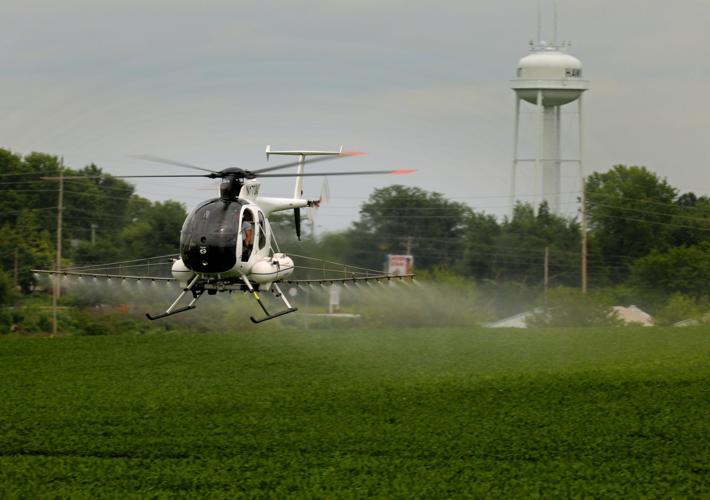HAWK POINT, Mo. — Shane Myers steered his blue pickup to the side of his company’s warehouse, kicking up a thick cloud of dust. The back was loaded with a pallet stacked with boxes of fungicides that, in just a few hours, would coat the surface of every corn and soybean plant in the adjacent 1,200 acres of farmland.
It was just another Monday for Myers, co-owner of Gateway Precision Ag. But for the six farmers whose fields his company was spraying, it meant their crops were protected from fungal disease, which costs the industry billions of dollars each year.
Now, a scientific breakthrough is quietly on the verge of revolutionizing agriculture. Scientists at the Donald Danforth Plant Science Center in Olivette have discovered a small clover that could hold the key to defeating a fungal disease that costs farmers worldwide more than . Moreover, researchers say, their discovery holds promise against other fungal diseases too.
People are also reading…
Danforth Center associate member Dilip Shah and his team are investigating a biologically active compound found in a European clover that works as a natural fungicide to stop gray mold disease — which infects more than 200 plant species, particularly fruits and flowers.
Instead of genetically modifying plants to produce the compound, a practice that some farmers and consumers and costly, researchers spray the compound, called a peptide, directly onto plants. In a published in Proceedings of the National Academy of Sciences in June, sprayed plants showed fewer signs of the disease.
“We think that this technology should be quite safe, effective, and sustainable,” said Shah, who oversaw the study. “We hope it’s possible to produce these peptides in a cost-effective manner.”
Plants with gray mold will develop soft, gray-green mushy spots on leaves, stems, flowers and fruit, causing them to shrivel and rot. Produce most often affected include apples, pears, peaches, plums, raspberries, strawberries, blackberries, blueberries, tomatoes, beans and grapes.
Consumers often run into the mold themselves, especially on strawberries that sit out for too long and develop fuzzy gray spots.
Gray mold is in agriculture.
“Fungus can just cannibalize the entire plant,” said Kyle Allen, co-owner of Gateway Precision Ag, who works with Myers to help farmers in Lincoln County deal with pests. Moreover, fungus spores spread easily through the air and can quickly proliferate in Missouri’s humid climate.
In 2008, for example, gray mold caused to raspberry plants in Iowa. Sanitizing fields after an outbreak involves removing dead and dying leaves and costs about .
A sustainable pesticide
Most farmers use synthetic fungicides to treat their plants. But they come with a cost: Some fungicides are Others hurt bees, and , among other things. Worse, fungus can quickly develop a resistance to fungicides. Just as there are strains of bacteria like the lethal MRSA, which causes an infection in humans that is highly resistant to antibiotics, fungi mutate, too.
That means farmers are constantly having to buy the newest fungicides.
“And it’s not an infinite toolbox,” said University of Minnesota assistant professor Brett Arenz, who heads the university’s Plant Disease Clinic. “It’s getting harder and harder to bring a fungicide to market — it can cost hundreds of millions of dollars.”
In the 19th century, scientists discovered broad spectrum pesticides, which control for weeds, insects and fungus indiscriminately, but which also inadvertently killed beneficial organisms, like pollinators. Since then, Arenz said, scientists have synthesized more chemicals that can control for one specific type of pest — but they also increase the likelihood that the pest will develop resistance.
To avoid resistance, Arenz recommends using fungicides only as a last-ditch effort and instead focusing on other factors that could be contributing to the fungal infection, like proper tilling and irrigation.
Scientists have been racing to find more sustainable pesticides to which fungi would not mutate as quickly.
While some synthetic fungicides can take more than a year to degrade, which can cause build-ups of the chemicals in the environment, Shah said that peptides, such as those in his study, will eventually break down to amino acids in the soil, which beneficial microbes can use as energy.
Shah and his team found the peptide by looking at the roots of the , a plant native to the Mediterranean area that scientists have studied extensively. When they first started studying the plant, Shah said his team had no idea it had anti-fungal capabilities.
Researchers modeled the 3D structure of the peptide and theorized how it deactivates fungus — the peptide infiltrates past tough fungus cell walls and, they believe, inhibits the fungus from making proteins, which are essential for its survival. In addition, the peptide latches onto the cell wall of fungus spores — their reproductive cells — and prevents them from growing.
Because the peptide attacks the fungus in multiple ways, it should be harder for the fungus to become resistant to it, Shah said.
Helicopter spraying
Shah’s team wasn’t the first to use peptides to control for pests.
In 2018, Michigan-based Vestaron began selling an insecticide derived from peptides that kills aphids, spider mites, thrips and whiteflies. Since then, the company has expanded and offers two other peptide-based insecticides.
But Shah says his spray is the first for fungi.
Other scientists say the idea has promise.
“The spray really is something special,” said USDA plant physiologist Autar Mattoo, who studies antimicrobial properties of plants and was not involved in Shah’s study. “It can replace what is commonly done in the fields today and make things simpler for the grower.”
Shah and his team have partnered with a company — which Shah didn’t identify — to mass-produce the peptide so they can test its efficacy on a larger scale. They also identified at least three other peptides that have similar anti-fungal properties, and are looking to find the one that is most effective and easiest to mass-produce.
While Shah and his team studied only gray mold in this experiment, they say the peptide spray could be used to control other fungi as well.
Allen, of Gateway Precision Ag, said Missouri farmers mainly worry about frogeye leaf spot on soybean plants and gray leaf spot, a fungus that causes long gray streaks on corn leaves and interferes with the corn’s ability to photosynthesize.
Farmers typically spray their crops with synthetic fungicides twice a season, in combination with other chemicals like insecticides and fertilizer, said Myers, Allen’s partner.
Myers said his team can spray as many as 1,000 acres in a single day, which uses more than 100 gallons of synthetic fungicide. This season, they are using four fungicides made by Bayer and BASF. All four chemicals are toxic to aquatic life and humans through inhalation or skin contact.
Both Myers and Allen were intrigued by the promise of a kinder, gentler, more effective fungus protection.
But it all comes down to farmers’ return on investment, said Myers. Farmers will consider using a natural fungicide if it’s cheaper than the current products.
“They don’t use the fungicide ‘cause it makes the crop look pretty,” he said, with a laugh. “It’s all about the future returns.”















